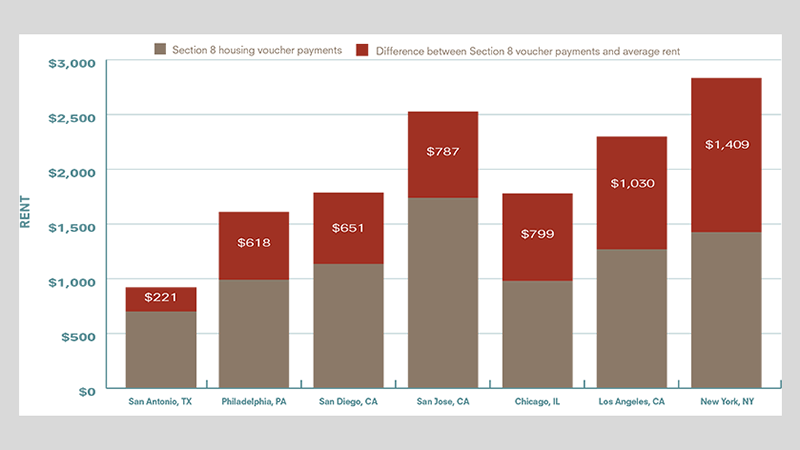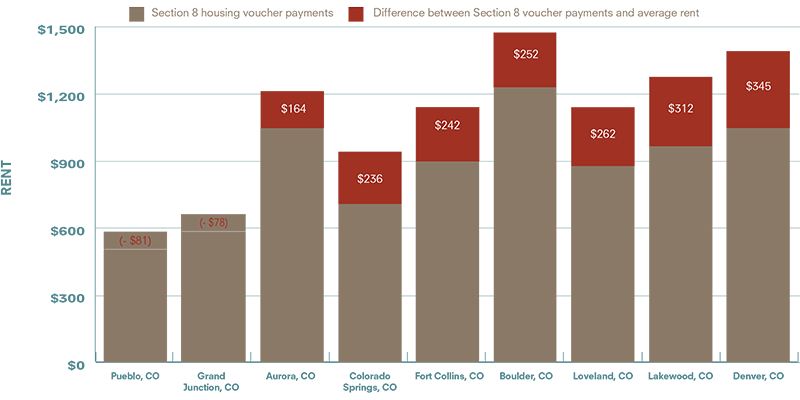
A comparison of Section 8 housing choice voucher payments and average one-bedroom rent rates in select U.S. cities.*
A comparison of Section 8 housing choice voucher payments and average one-bedroom rent rates in select U.S. cities.*
A little over a decade ago, Carmen Sanders-Ward and her growing family were struggling to make ends meet in Georgia when Hurricane Katrina hit. Luckily, her family qualified for and was granted a housing choice voucher under Section 8, which allowed Sanders-Ward to relocate with her family back to her hometown of Dallas, Texas.
Established in 1974, the Section 8 housing choice program was created with the intent of expanding housing options for low-income families, who can rent any approved units that match their family size, with certain restrictions. But there is a big catch: Voucher holders can only rent apartments that fit the costs determined by the housing authority—calculated at the 40th to 50th percentile of rents in a general metro area.
For Sanders-Ward, that meant her rental choices were limited to high-poverty neighborhoods, which in turn impacted her five children, especially her adolescent son.
“He was getting in a lot of trouble,” says Sanders-Ward, 39. Additionally, one of her twin daughters was having a hard time in her school, where the student-to-teacher ratio in her class was 30:1.
Things changed drastically for the Sanders-Ward family two years ago, after a landmark Texas court settlement in 2010 allowed them to move from Pleasant Grove—a racially segregated section of Dallas County with a high poverty rate—to the more upscale city of McKinney. The settlement resulted from a lawsuit brought by a Texas-based nonprofit that challenged one of the major underlying assumptions of the housing voucher program: how payments are calculated.
Housing choice vouchers are an alternative to Section 8 project vouchers that are tied to specific buildings, in order to allow the holder more mobility and options. Currently, 2.2 million households in the United States have housing choice vouchers, or about 6 percent of the rental housing market. Once a voucher holder finds an apartment, they are only expected to pay approximately a third of their monthly income toward rent to their landlords, while the government covers the remaining cost.
As of 2010, approximately half of all voucher holders were elderly and/or disabled. Nationwide, among voucher households with children, the Center for Budget Policy and Priorities found that 57 percent were black, 23.3 percent were white and 16 percent were Hispanic. Yet of these, 66.8 percent of black families with vouchers were found to be living in “extreme-poverty neighborhoods”—defined by the Census as those where 40 percent or more of the residents live below the poverty line—compared to only 14.6 percent of white voucher holders with children.
The rent rates eligible for the voucher program are set each year by local housing authorities, which also handle voucher distribution. But because of the low percentile by which they are set, there is often a major disparity between these rates, known as payment standards, and the majority of housing rental rates in a given area.
For instance, the payment standard set under the Section 8 voucher program for Boulder, Colo. for a two-bedroom apartment as of October 1 was $1,365. This means a family looking for a two-bedroom apartment last year in Boulder would have had to find an apartment renting for this amount or less in order to be able to actually use their voucher.
Yet the average rent for a two-bedroom unit in Boulder as of September 2016 was $1,789. Not only that, but a voucher holder usually only has between 90 and 120 days to attain a qualifying apartment, or they can lose their voucher.

Housing vouchers issued under the Section 8 housing choice program don’t match average rents for one-bedrooms in many Colorado cities.**
“Because of market saturation, housing choice vouchers are often rejected [by potential landlords] and they’re not able to find apartments for market rate to use their vouchers,” says Christi Romero-Roseth, who offers assistance to disabled voucher holders in Colorado in her role as the intake coordinator at the Colorado Fund for People with Disabilities. “This causes a problem because very little [in a person’s life] becomes stable or moves forward when housing is unstable.”
Jerry, a 54-year-old homeless veteran in Denver, was awarded a voucher in September, but a month later, he hadn’t been able to use it. (Jerry asked that only his first name be used, for privacy reasons.)
“There are a lot places that are just too expensive,” says Jerry. “The market is real tight and it seems impossible to find a place.”
If Jerry is unable to find a home, it will mark his second consecutive winter living on the street.
The Denver metro area has experienced a 6.4 percent increase in the number of chronically homeless between 2015 and 2016, and a 21 percent increase in homeless veterans in the same timeframe. Meanwhile, rental prices throughout the metro area increased 3.2 percent in just the past year, the Denver Post reported, citing ApartmentList.com data. But that increase pales in comparison to the 10.4 percent yearly increase in rental rates in Colorado Springs—the highest in the nation.
Rents rose 6.2 percent in Colorado between February 2015 and March 2016, according to Denver Real Estate Watch—more than triple the national average. Meanwhile, 623 more Colorado school children became homeless from the 2013-14 to 2014-15 school years. This likely isn’t a coincidence.
Even for those fortunate enough to get a voucher and find an affordable apartment that adheres to the payment standard regulations, their options are often limited to high-poverty neighborhoods.
“Because of the way most of our metro areas have developed, there is a lot of exclusion of lower-income housing from suburban areas,” says Philip Tegeler, who is the executive director of the Poverty & Race Research Action Council, which works to promote housing mobility under a social justice framework. “This makes it a civil rights issue.”
Tegeler says this inhibits social mobility for voucher holders. Studies have found that vouchers only cover the cost of 15 percent of units in wealthier neighborhoods, but 68 percent in poorer neighborhoods. This means voucher holders are less likely to have the educational and professional opportunities, green spaces, lower crime rates and health care access that living in a more affluent area often allows—which, in turn, has long-term and sometimes serious implications for health and earning potential.
In particular, Tegeler notes studies that have revealed improved mental health for women and girls, lowered rates of diabetes and improved academic performances for school-aged children that move to better neighborhoods. By contrast, being in high-crime neighborhoods can cause children to suffer from what the American Academy of Pediatrics refers to as “toxic stress,” which predisposes them to higher risks of strokes, heart disease, cancer and depression in adulthood.
Furthermore, a 2015 study conducted by researchers at Harvard and Stanford universities found that every extra year a child spends in a higher-quality neighborhood—in this case, one that is less racially segregated, has higher-ranking public schools and lower crime rates—improves adulthood income later in life.
According to the study, growing up in a neighborhood that is even marginally better than the one a child was born in has been found to increase income projections as an adult by an average of 10 percent. The researchers dubbed this phenomenon the “childhood exposure effect,” which tends to be more pronounced in girls. This exposure effect can predict a range of outcomes dependent on a child’s place of upbringing, including likelihood of teenage pregnancy and college attendance.
In 2010, the Inclusive Communities Project, a nonprofit group that advocates for affordable housing in the state of Texas, sued the U.S. Department of Housing and Urban Development (HUD) over the methods it used to calculate payment for voucher holders in Dallas, of which nearly 90 percent are African American. HUD eventually reached a settlement that implemented new payment standards starting in 2011 for the larger Dallas metro area, calculated by zip code rather than a blanket rate for a larger metro area and all its outlying suburbs.
Five years after that settlement, the Dallas experiment has been deemed successful in offering families like the Sanders-Ward clan opportunities to relocate to better neighborhoods. One comprehensive study even concluded that transitioning payment standards to zip codes in the Dallas area not only contributed to significant improvements in neighborhood quality for voucher holders, but that the program had a zero net cost for the government.
This success story motivated HUD to propose a new rule this past summer to expand the zip code-based payment standards to encompass another 31 metropolitan areas, including Colorado Springs. If it passes, the new standards are expected to go into effect sometime starting in 2017. Though some are hopeful the expansion of this program will lead to improvements in social mobility for voucher holders, others are more apprehensive, saying it could have unintended consequences.
“I certainly think is it a nice concept, but do have some concerns with how the final rule may complicate things,” says Chad Wright, executive director of the Colorado Springs Housing Authority.
According to Wright, the new rules might mean the housing authority has to serve locations in rental markets they have not previously worked in, and have no prior familiarity with, while on a limited budget. He is also concerned that changing the payment standards could undermine investments in low-income neighborhoods.
“We don’t want it to disincentivize [investments in] and hurt low-income neighborhoods that already have enough challenges,” says Wright. “I just hope there is consideration for the increased complexity with what housing authorities already have to do with slashed funding.”
If the zip code-based payment program proves as successful in Colorado Springs and other cities as it did in Dallas, HUD has proposed allowing other housing authorities to opt into the program voluntarily. While it’s a start, Tegeler hopes that it will be eventually mandated for all municipalities in the U.S., and that incentives will be offered to housing authorities to help voucher holders move to wherever they want.
“The most important thing is these families have the right to move to the community of their choice,” says Tegeler. “They shouldn’t be constrained to a certain area.”
In Sanders-Ward’s case, the move to McKinney meant her children began attending the higher-rated schools of the Frisco district. Once there, her daughter was diagnosed with a learning disability and offered individualized assistance. In fact, all of her children are now not only caught up, but progressing academically. This includes her son, who is now a junior in high school.
“His mind is in his books now,” says Sanders-Ward. “He is doing much better and prepping for college.”
*Source (U.S.): Housing voucher payment standards from metro housing authorities and state government websites. Rent averages from Rent Jungle as of August 2016.
**Source (Colorado): Housing voucher payment standards from metro housing authorities; Rent averages from Rent Jungle as of August 2016.
Laura Kiesel is a freelance reporter who has written for The Atlantic, The Guardian, Salon, Al-Jazeera America, Fusion and other outlets. She lives in the Boston area.